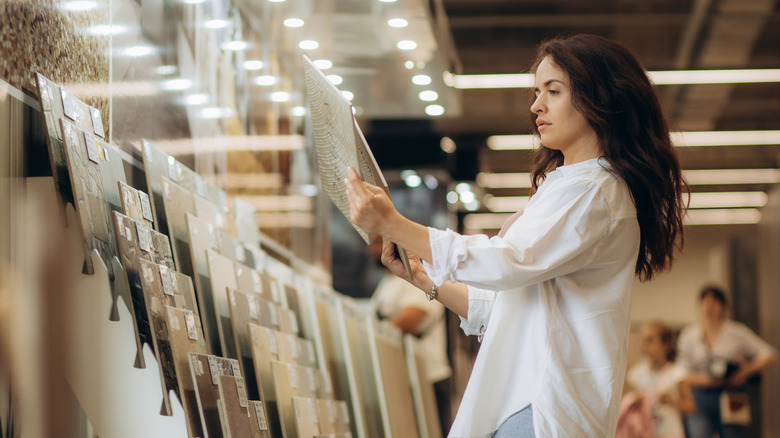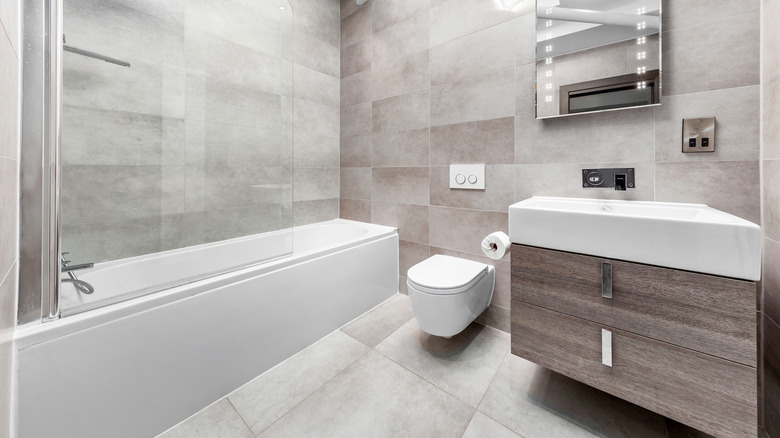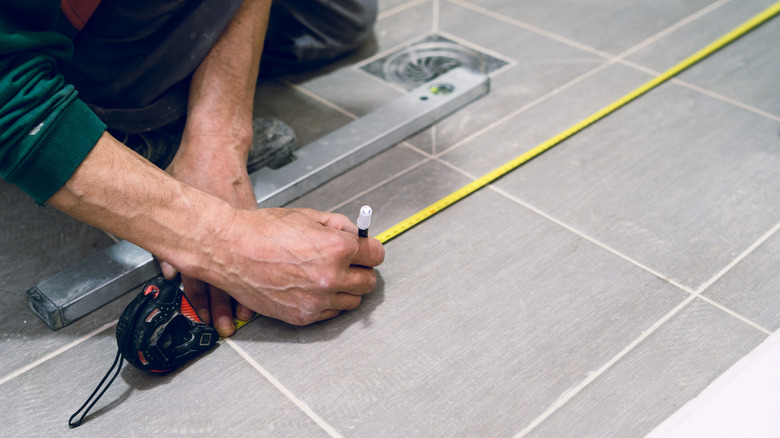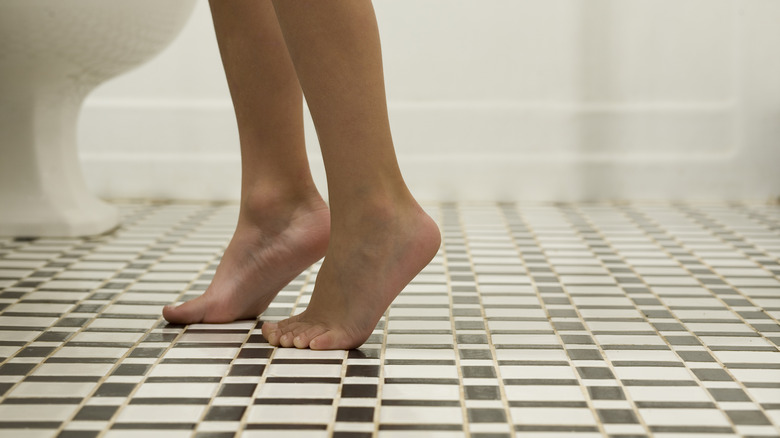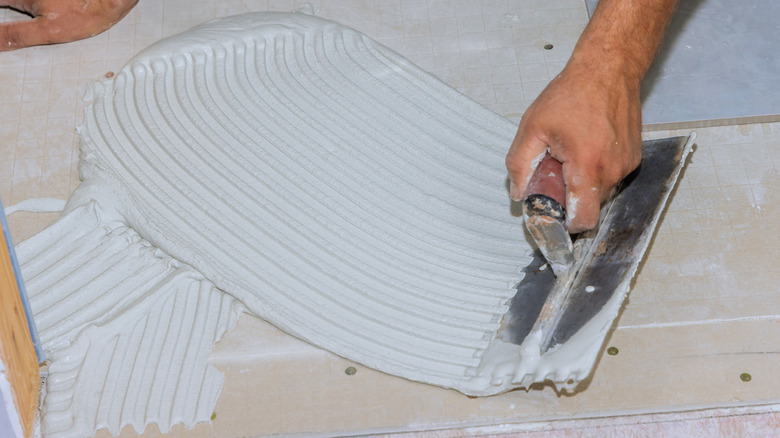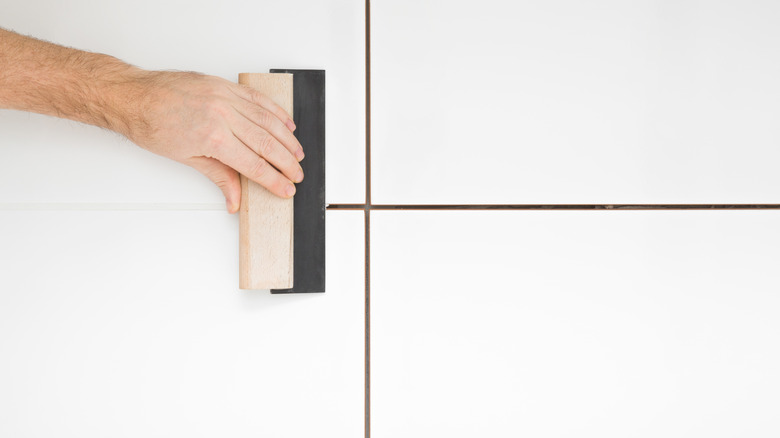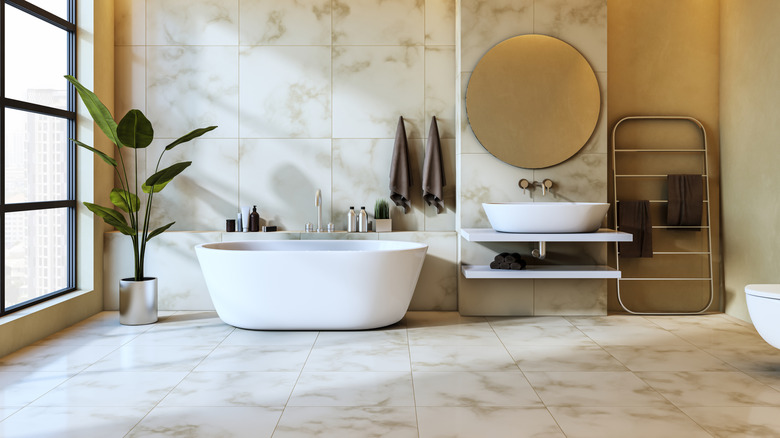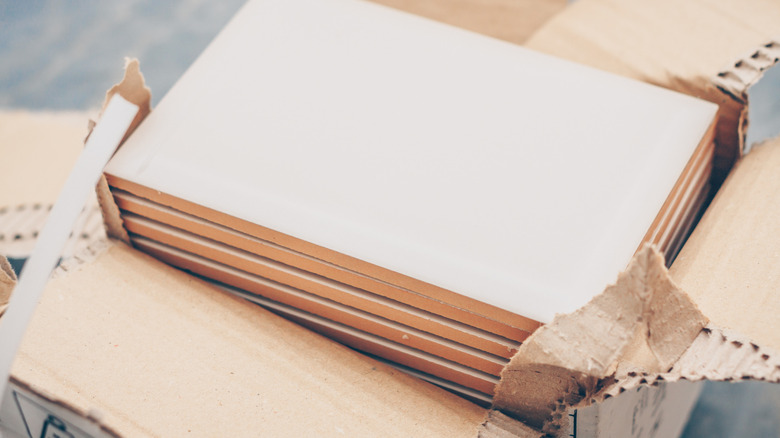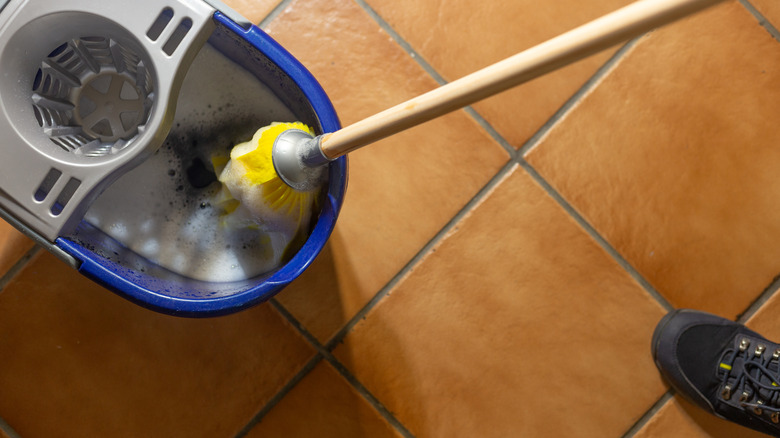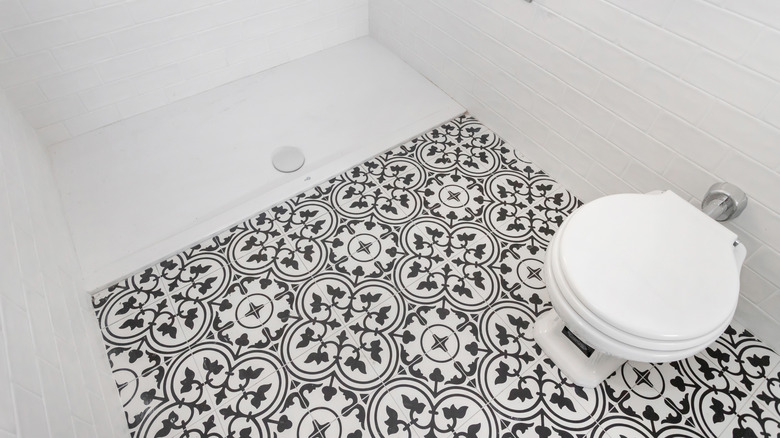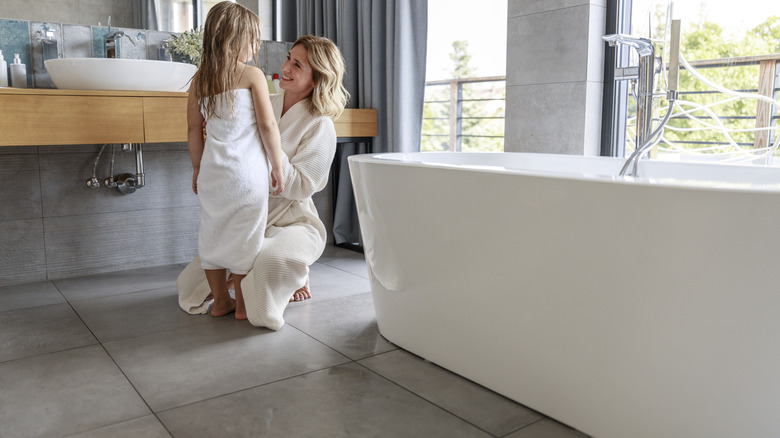15 Bathroom Flooring Mistakes To Avoid At All Costs
Your bathroom flooring has a big impact on the room's overall functionality and style. But because it's constantly exposed to water and humidity, the wrong choice in materials or an installation without preparation can lead to costly problems down the line. With projects costing hundreds, or even thousands of dollars, even a small mistake can become one you end up regretting. Yet many DIYers and homeowners miss simple details that make a big difference, including selecting unsuitable materials and forgetting about important prep work.
Most of these pitfalls are easy to avoid once you know what to look for. When you understand how certain flooring materials perform in wet spaces, how to properly prepare your subfloor, and what design choices best suit your lifestyle, you can install bathroom flooring that's stylish and will last for years to come. Before you even start to measure the space or weigh up material options, take a moment to explore these common bathroom flooring mistakes.
Not comparing bathroom flooring prices
A common mistake that homeowners make when updating their bathroom flooring is choosing materials at the cheapest price they can find. With so many options, including vinyl, laminate, and even natural stone, it's easy to assume that all stores charge roughly the same. But even a minor difference per square foot can add up quickly when you're covering an entire bathroom floor. For example, a flooring material might vary by only a dollar per square foot between retailers. Although that variance may seem small, the total difference can end up being much higher, especially if you're working with a big space.
So, research prices before you purchase your flooring materials. Set aside some time to compare online prices at different retailers, and keep in mind you'll likely have to pay for delivery or shipping, too. It's a good idea to look for promotions or bulk discounts, and clearance sales that can help you save even more. Keeping a basic spreadsheet of notes on each flooring option's cost per square foot can help you see the price differences at a glance. You can avoid overpaying for the same product and free up extra budget for other bathroom upgrades by taking a little time to get the best price.
Ignoring flooring interior design trends
When you're shopping around for flooring options, it's easy to ignore interior design trends and opt for safe and familiar choices like plain tiles or basic vinyl without considering what's popular or visually inspiring. While these materials can be practical, they may leave your bathroom looking a little uninspired. There are unique bathroom design ideas you shouldn't overlook, and they reflect how materials and layouts can totally change and enhance a space. For instance, large-format tiles are a popular bathroom flooring trend because they create a sense of space and luxury that small tiles don't.
A smaller area, like a bathroom, is a good chance to try these design ideas. So, research the latest bathroom flooring trends before selecting your materials. Look at design websites and social media platforms like Pinterest and Instagram to find out which materials and layouts are popular and why. Experimenting with these trends doesn't mean you have to spend a lot. It can simply inspire an interesting take on a classic design. For example, pairing large-format tiles with a neutral color palette can create a timeless look and feel for the space.
Not choosing a waterproof material
A costly mistake DIYers may make when selecting bathroom flooring is not considering how important it is to use waterproof materials. Bathrooms are usually humid, and your floor will get wet with splashes from showers and sinks. Choosing a non-waterproof laminate or material that isn't sealed might seem fine, but over time, moisture can cause the flooring to swell, lift, or warp. Many people make this misstep because they focus on the price tag or aesthetics while assuming that all types of flooring will withstand a wet environment. Unfortunately, ignoring waterproofing can lead to frequent repairs and replacements, which result in unexpected expenses.
When shopping, narrow your focus to waterproof or water-resistant options. Vinyl planks, porcelain tiles, and properly sealed natural stone are great choices for damp bathrooms. Take extra care to check product specifications for waterproof ratings and follow the manufacturer's installation guidance for the best results. Also, ensure that seams and edges are correctly installed to prevent moisture from seeping beneath the surface. Investing in waterproof flooring materials upfront protects your bathroom from water damage and extends the life of your flooring.
Purchasing the wrong amount of flooring
Miscalculating how much material you need during a bathroom flooring project can lead to a lot of frustration. Running out of flooring halfway through your installation can slow you down and result in multiple trips to the store or repeated orders. It may even mean mismatched tile batches if you need to reorder later on. Running out of material is common with patterned materials, where cuts and mistakes can add up quickly. Precisely trimming around fixtures like toilets could lead to errors along the way.
The easiest way to avoid this happening is to plan ahead and order extra flooring. You'll typically need 5% to 15% more than the room's square footage to be on the safe side. This buffer allows for mistakes and is handy for any future repairs that may be needed. If you're not sure about how much flooring to buy, online flooring calculators can give you an estimate based on your bathroom's dimensions and layout. Keep in mind that you may need to allow for more waste when installing patterned or large-format tiles because of alignment and cutting.
Not considering anti-slip flooring for a wet environment
Another bathroom design mishap is selecting flooring without considering slip resistance. Even a small puddle of water on your bathroom floor can quickly become a slippery accident. Many homeowners focus on aesthetically appealing finishes, like glossy tiles or polished stone, without weighing up the safety of these materials. These are sleek bathroom floor materials to avoid. The consequences of a slippery floor can be serious, especially for children or older adults.
The solution is to prioritize non-slip flooring from the start. Look for tiles or planks that specifically mention non-slip or slip-resistant features, like porcelain and ceramic tiles with a textured finish. Many manufacturers specify an R-rating for tiles, which indicates their level of slip-resistance. So for a bathroom with a tub or shower, look for a rating of at least R10, suitable for wet environments. For vinyl and other synthetic materials, look for embossed or matte finishes that give you some traction. For more safety, combine your choice of flooring with practical items like anti-slip bath mats.
Improperly preparing your surfaces before installing your flooring
If you're installing bathroom flooring yourself, skipping or rushing the preparation of your subfloor is another blunder you'll want to avoid. You may come up with the perfect tile idea to revamp your space. But you'll have problems down the line if the surface underneath isn't properly prepared. Uneven or damp subfloors can cause tiles to crack and vinyl planks to lift over time. Even minor issues can become big problems once your flooring is laid, which can lead to costly repairs and a less polished look.
Be sure to set aside extra time to prepare the surface before you install your flooring. For concrete subfloors, ensure the surface is clean, completely dry, and perfectly level. Small bumps or dips can be smoothed with a leveling compound, and dust and debris should be removed. For wooden subfloors, check for loose boards or nails, and sand the surface if needed. These little additional steps will ensure that your flooring adheres properly and evenly, and that it lasts until you're ready for another bathroom floor refresh.
Not using grout correctly
When it comes to bathroom flooring, grout often doesn't get the consideration it deserves. However, it could ruin both the look and lifespan of your tiling installation. Choosing the wrong color and forgetting to seal it are oversights you should avoid. Though the lines are small, the grout color can have a big impact on your bathroom's overall aesthetic. For example, a bright white grout with dark tiles creates a nice contrast, while matching up your tones can create a modern finish. Not applying your grout correctly or not sealing it means the material is susceptible to moisture damage and staining.
If you want to avoid these issues, be prepared to spend a bit more time selecting the right grout and applying it correctly. Choose a high-quality, stain-resistant product designed for wet areas, and make sure you seal it thoroughly once it's cured. Regular resealing can also help maintain its resistance to water and stains. If you're unsure about which color to go with, test small samples first to see how they look once they've dried. Also, it's essential to maintain your grout by wiping down tile lines regularly to stop grime from building up.
Failing to consider size perception
A design mistake you could be making is not considering how your choice of flooring material affects the perception of your space. In smaller bathrooms, the wrong flooring, such as busy patterns, can be a design choice that makes your space feel cluttered. A lot of people only consider durability or color preference without realizing that visual proportions impact how spacious your bathroom will feel.
You can make your small bathroom seem bigger with some clever ideas. Think about how size, color, and layout influence your bathroom's overall perception. Larger tiles or luxury vinyl tile planks result in fewer grout lines, which may give you a roomier look and feel. Light colors, like soft gray or beige, tend to reflect more light, which can create an illusion of depth. If you prefer patterns, choose subtle, elongated designs that draw the eye lengthwise across the room. Installing flooring on a diagonal can also make smaller spaces appear wider.
Storing your bathroom flooring incorrectly before installation
There's another thing that many DIYers don't think about before their installation: Not storing bathroom flooring properly. You may think flooring material is durable enough to handle a few days stacked in a corner in your garage, but improper storage can cause damage. Tiles, for example, should never be piled directly on top of each other without some form of protective padding. Not doing this can lead to cracks, chips, or scratches before your tiles even reach your bathroom. Vinyl and laminate planks can warp if they're left in areas with extreme temperatures. You don't want to damage the materials that you've just invested in.
To prevent this setback, always store your flooring in a temperature-controlled space. Keep tiles laid flat in their boxes and separate them with cardboard or foam padding. For vinyl flooring, let the planks acclimate in your bathroom for 48 hours before starting your installation, as this helps them adjust to the environment and prevents warping. Storing your flooring materials properly makes sure they stay in perfect condition until you're ready to start installing them.
Not thinking about cleaning issues ahead of your purchase
A common oversight when choosing bathroom flooring is forgetting to think about how easy (or difficult) the material will be to clean. Many homeowners get caught up in how a material looks or feels, without considering its long-term cleaning and maintenance. Textured tiles, for example, may add great depth and grip, but they can also trap dirt and grime in their grooves and crevices. Highly polished finishes might show every water spot, which makes it difficult to keep them looking clean. High-maintenance flooring can quickly become a big chore.
Think practically about your cleaning habits before you buy your flooring material. If you prefer a lower-effort routine, choose smoother, sealed materials that resist stains and moisture, like porcelain, glazed ceramic, or LVT. These materials are typically easy to wipe down and don't need much upkeep. For textured finishes or natural stone, plan ahead by sealing these surfaces often and using the right cleaning products to stop buildup.
Including too many patterns in the space at the same time
When you're shopping for your bathroom flooring project, be cautious of getting carried away with patterns. What starts as personalizing a space with your specific tastes can quickly become too much when you've got heavily patterned floors and walls competing with one another. You may love multiple styles, or you could be trying to make a small space more interesting. However, too many intricate designs can be overwhelming to the eye and make the space feel tighter.
To strike the right balance, select one or two patterns that complement each other. For example, a geometric tile floor can pair really well with solid-colored walls and minimalist fixtures. If you love color, think about varying scale for subtle contrast by mixing large-format tiles with a backsplash of smaller tiles in the same hue. Stick to a consistent color palette to bring everything together, and use textures or different finishes to add dimension to the space rather than extra prints.
Not taking your lifestyle into consideration in your design
A beautiful bathroom floor doesn't mean much if it doesn't suit your day-to-day life. A mistake homeowners often make is failing to consider the practical side of flooring materials, like how they'll hold up to household routines. For example, a delicate natural stone may look stunning, but in a bathroom with a lot of traffic and users, it can quickly scratch or stain.
Choose your flooring based on how you typically use the space, not just on how you want your bathroom to look. If you are choosing flooring for a busy bathroom, porcelain and ceramic tiles are a good choice because they're durable and easy to clean. Pet owners might prefer luxury vinyl tiles, as they resist scratches and can be vacuumed or mopped in a jiffy after pet messes. Keep in mind that different bathrooms may also have different needs. Your kids' bathroom may demand the ultimate durability. However you can likely get away with a wider range of choices in the powder room or guest bath.
Neglecting underfloor heating for added comfort
One key detail in your bathroom that can make a world of difference is underfloor heating, yet many homeowners don't consider installing this. Not including this feature in your bathroom may seem like a way to save money during a remodel, but during chilly winter months, it can be a lifesaver. Stepping onto cold tiles after a warm bath or shower can make your bathroom feel a lot less inviting. Cold can also mean your bathroom flooring will dry more slowly, which could lead to mold, stains, or a dangerously slippery surface.
Instead of relying on your furnace or towel warmers, consider investing in underfloor heating during your installation. Electric systems are pretty straightforward to install beneath the flooring and can be easily controlled with a thermostat. They also distribute heat evenly throughout the room, keeping it warmer for longer without high energy costs. By drying floors faster, underfloor heating means you'll have cleaner and safer flooring to step onto.
Not visiting a flooring showroom or store to view your options
With online shopping so popular these days, people often think they can choose flooring materials from a few professionally shot photos. But these images can be misleading. Colors may look different in person because of variations in lighting, and essential details like texture and how materials feel underfoot can't be judged from a screen. Ordering materials online may be convenient, but they may end up clashing with your bathroom design once you've installed them.
So, visit a flooring showroom or home improvement store before buying your flooring materials. Seeing and touching samples up close lets you compare aspects like texture and finishes under realistic lighting. Another benefit is that you'll be able to speak directly with flooring experts, who can give you some guidance as to the best materials for your space and budget. Some showrooms also give you samples to test at home to help you make a more informed decision.
